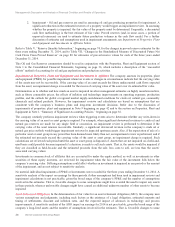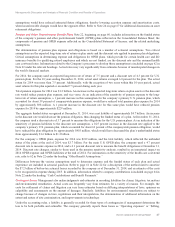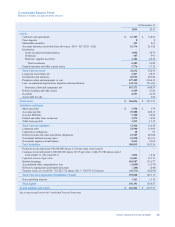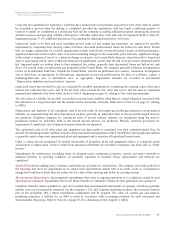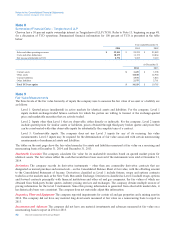Chevron 2014 Annual Report Download - page 38
Download and view the complete annual report
Please find page 38 of the 2014 Chevron annual report below. You can navigate through the pages in the report by either clicking on the pages listed below, or by using the keyword search tool below to find specific information within the annual report.Notes to the Consolidated Financial Statements
Millions of dollars, except per-share amounts
Note 1
Summary of Significant Accounting Policies
General The company’s Consolidated Financial Statements are prepared in accordance with accounting principles generally
accepted in the United States of America. These require the use of estimates and assumptions that affect the assets, liabilities,
revenues and expenses reported in the financial statements, as well as amounts included in the notes thereto, including
discussion and disclosure of contingent liabilities. Although the company uses its best estimates and judgments, actual results
could differ from these estimates as future confirming events occur.
Subsidiary and Affiliated Companies The Consolidated Financial Statements include the accounts of controlled subsidiary
companies more than 50 percent-owned and any variable-interest entities in which the company is the primary beneficiary.
Undivided interests in oil and gas joint ventures and certain other assets are consolidated on a proportionate basis.
Investments in and advances to affiliates in which the company has a substantial ownership interest of approximately
20 percent to 50 percent, or for which the company exercises significant influence but not control over policy decisions, are
accounted for by the equity method. As part of that accounting, the company recognizes gains and losses that arise from the
issuance of stock by an affiliate that results in changes in the company’s proportionate share of the dollar amount of the
affiliate’s equity currently in income.
Investments in affiliates are assessed for possible impairment when events indicate that the fair value of the investment may
be below the company’s carrying value. When such a condition is deemed to be other than temporary, the carrying value of
the investment is written down to its fair value, and the amount of the write-down is included in net income. In making the
determination as to whether a decline is other than temporary, the company considers such factors as the duration and extent
of the decline, the investee’s financial performance, and the company’s ability and intention to retain its investment for a
period that will be sufficient to allow for any anticipated recovery in the investment’s market value. The new cost basis of
investments in these equity investees is not changed for subsequent recoveries in fair value.
Differences between the company’s carrying value of an equity investment and its underlying equity in the net assets of the
affiliate are assigned to the extent practicable to specific assets and liabilities based on the company’s analysis of the various
factors giving rise to the difference. When appropriate, the company’s share of the affiliate’s reported earnings is adjusted
quarterly to reflect the difference between these allocated values and the affiliate’s historical book values.
Derivatives The majority of the company’s activity in derivative commodity instruments is intended to manage the financial
risk posed by physical transactions. For some of this derivative activity, generally limited to large, discrete or infrequently
occurring transactions, the company may elect to apply fair value or cash flow hedge accounting. For other similar derivative
instruments, generally because of the short-term nature of the contracts or their limited use, the company does not apply
hedge accounting, and changes in the fair value of those contracts are reflected in current income. For the company’s
commodity trading activity, gains and losses from derivative instruments are reported in current income. The company may
enter into interest rate swaps from time to time as part of its overall strategy to manage the interest rate risk on its debt.
Interest rate swaps related to a portion of the company’s fixed-rate debt, if any, may be accounted for as fair value hedges.
Interest rate swaps related to floating-rate debt, if any, are recorded at fair value on the balance sheet with resulting gains and
losses reflected in income. Where Chevron is a party to master netting arrangements, fair value receivable and payable
amounts recognized for derivative instruments executed with the same counterparty are generally offset on the balance sheet.
Short-Term Investments All short-term investments are classified as available for sale and are in highly liquid debt
securities. Those investments that are part of the company’s cash management portfolio and have original maturities of three
months or less are reported as “Cash equivalents.” Bank time deposits with maturities greater than 90 days are reported as
“Time deposits.” The balance of short-term investments is reported as “Marketable securities” and is marked-to-market, with
any unrealized gains or losses included in “Other comprehensive income.”
Inventories Crude oil, petroleum products and chemicals inventories are generally stated at cost, using a last-in, first-out
method. In the aggregate, these costs are below market. “Materials, supplies and other” inventories generally are stated at
average cost.
Properties, Plant and Equipment The successful efforts method is used for crude oil and natural gas exploration and
production activities. All costs for development wells, related plant and equipment, proved mineral interests in crude oil and
natural gas properties, and related asset retirement obligation (ARO) assets are capitalized. Costs of exploratory wells are
capitalized pending determination of whether the wells found proved reserves. Costs of wells that are assigned proved
reserves remain capitalized.
36 Chevron Corporation 2014 Annual Report


